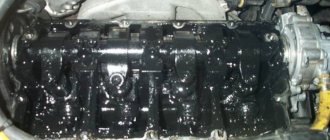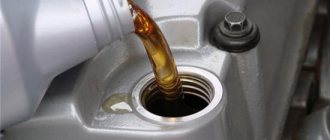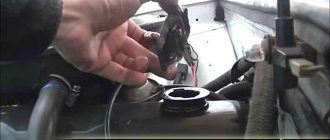For many drivers during the period of winter operation of the car, the problem of cold engine starting is well known. As a rule, it is most difficult to start the engine in severe frosts. At the same time, the ease of starting a cold internal combustion engine is influenced by many factors, ranging from the battery charge level or the condition of the spark/glow plugs to the viscosity of the engine oil in the crankcase of the power unit.
As for the oil, a lubricant that is too viscous makes it very difficult for the crankshaft to rotate; as a result, the starter is unable to spin the crankshaft to the required frequency, the battery charge is quickly consumed and the car cannot be started.
It is also important to consider that even if the engine starts, but the oil is too thick, in the first seconds after starting the engine experiences oil starvation, since proper lubrication does not occur. As a result, accelerated wear of the CPG, timing elements and crankshafts is observed.
To solve the problem, you can seasonally use expensive synthetic low-viscosity “winter” oils, however, this type of lubricant is not always suitable for a particular type of engine for a number of reasons. The main thing is a strong dilution of the oil after the engine reaches operating temperatures, leaks of oil seals and gaskets, a decrease in pressure in the lubrication system and increased wear of engine parts.
Another method is to preheat the engine crankcase before starting to get rid of a strong increase in the viscosity of the lubricant in a cold internal combustion engine. Let's look at this point in more detail.
Is it necessary to warm up the oil in the engine crankcase in winter before starting?
Drivers
It is clear that the interest in how to warm up the oil in the engine before starting is not caused by empty talk. How else can you take a lecture from a respected professor who compares 5 seconds of cranking at -20°C with three-digit mileage. The average equivalent is no more or less – 200 km. The dry theory does not specify specifically whether in the city or on the highway, but the essence is clear - the oil system is not in rhythm at the start-up stage. The physics is simple: oil is a liquid, and it thickens in the cold. Scientifically, as the temperature decreases, the low-temperature viscosity increases. To what extent is not clear: automotive lubricant manufacturers keep thematic diagrams secret. It is easier to teach information according to the SAE classification: the fewer details, the more convenient it is for marketers.
Soviet mineral water tests bring clarity. Let's take the most liquid mineral oil M8. Temperature gradient – from room temperature to -5°C. The result is a tenfold deterioration in viscosity characteristics. Modern synthetics, of course, do not thicken as intensely, but the hint was taken.
For whom the theory is an empty argument, we present the facts. The thick oil composition prevents the rapid rotation of the crankshaft and is poorly pumped, which is why:
- The life of the starter is reduced.
- The load on the battery is increasing.
- Oil starvation occurs in the first minutes of work.
General recommendations
Universal advice is to study the section on technical fluids available in the owner's manual for a specific vehicle. A table linking the viscosity of oils with their operating temperature limits will give you the idea that it would be a good idea to fill in something like 0W-40, 0W-30 for the winter.
The share of starting wear will decrease, but it is far from reaching summer values. Yes, and not all car manufacturers give the green light to the use of the super-fluid variety, but you shouldn’t violate the instructions - you will run out of lubrication and the seals will leak. Hence the question - how can you heat the engine oil in winter in pre-start mode.
Another option is to not allow the oil composition to cool down before the next start. Obviously, after a forced stop for 15-30 minutes or after the “Start-Stop” system has been activated, the starting conditions are equivalent to summer ones. Almost all modern alarm systems can automatically start and stop the engine. The function is called autostart based on engine temperature.
Emergency heating or how to heat the oil in the engine crankcase before starting in cold weather
Increased fuel consumption from frequent warm-ups is successfully forgotten when the mortal body is immersed in a warm cabin. Another concern is the unattended operation of the engine, you never know what can happen. And the neighbors on the first floor are not happy with the exhaust fumes, and conflict is not far away.
Old-fashioned methods
A proven way to heat up the oil is to heat the crankcase with an open fire. A blowtorch or a bunch of wood chips neatly stacked under the object to be heated will help you get a fire. Plus - there is no need to re-equip any machine system.
- Directing the same blowtorch to the required location is difficult, and sometimes even impossible, due to the small clearance or installed protection.
- Open flames pose a high risk of fire because they are concentrated near rubber and plastic parts.
Modern methods
Safe recipes for heating the oil in the crankcase before starting are based on obtaining heat from an electric current. Where to get it from depends on where the car is stored: in a street parking lot, autonomous power supply from the battery is preferable; in a garage, it can be powered from a household network.
The electric heater is different from that used in the antifreeze heating system from the muffler, but is similar to the glow plug, which is an integral part of the flow-through coolant heater. Generally speaking, there are several electrical oil heating schemes:
- External “heater”: a heating plate (220 V) is installed on the outside of the bottom engine cover.
- Electric dipstick: Through the hole for the oil dipstick, a flexible element is temporarily integrated into the crankcase, which heats up when electric current from a standard battery (12 V) is passed through it.
- Modified drain plug: instead of the standard plug, a part with a built-in heater (12 V) is mounted.
- Heating element: a tubular heating element (220V) is integrated inside the crankcase.
The heating rate and type of power supply are the main guidelines when choosing an idea. The best qualities among autonomous devices are shown by the electrical probe. A 220 V heating element heats the fastest, but its installation is fraught with difficulties.
Traditional methods of thinning grease in frosty weather
What to do if it is not possible to warm up the engine through the dipstick, or the starting heater has failed, or frost has suddenly struck, and you were not prepared for such an eventuality? In this case, you can use any available means that you can find in the garage, at home, or in the office. Heating must begin precisely from the area where the engine crankcase is located. In earlier times, drivers used blowtorches effectively. This is the easiest way to make the lubricant more liquid with your own hands and in a short period of time.
However, you should adhere to some fire safety rules. First of all, you need to understand how tight the lubrication system and the power system are, along with all their elements, since both fuel and oil are flammable substances. It is important to observe a safe distance, which should be at least half a meter from an open flame source to the oil pan. Another way to solve the problem is to drain the oil from the crankcase, then heat it to 70–80 degrees and refill it through the neck of the cylinder block.
This method is still practiced by drivers of heavy-duty trucks. For them, a flexible heater that is inserted through the dipstick hole will not have the desired effect. That’s why they so often install any household electric heater in the engine tray, which is connected to the electrical network via an extension cord. At the same time, their power should not exceed 0.5 kW in order to prevent overheating of the lubricant and deterioration of its performance characteristics.
How to warm up the oil in winter - we tried to answer this question for our subscribers in today’s publication. We hope that with the help of the information received, you will not have any difficulties starting the power unit even in the coldest months of the year and even in regions with the most severe climatic conditions. Don’t forget to recommend us to your friends and acquaintances who are also interested in automotive topics. See you again, friends!
Briefly about the main thing
An electric probe, a heated drain plug, a heating element and a heating plate - with these simple means you can safely heat the oil inside the engine in winter before starting. In fact, you don’t need to invent anything - each of the four options is available for purchase on many trading platforms.
In terms of power supply, there are no difficulties: a wire and a plug or a simple electrical circuit based on a relay and a toggle switch. Another question is whether it is necessary. The answer is short and advisory in nature: it is necessary, especially in cold weather worse than -10°C.
I decided to make my own pre-heater for 12V engine oil.
The heater must be screwed into the engine sump drain hole.
I modified the standard plug: I drilled a hole deep, leaving 5 mm to the outer end. I cut the internal thread M14x1.5. I drilled a hole in the end with a diameter of 8 mm for a textolite bushing through which I will output the contact (+).
I machined a ribbed glass Dn=19mm long L=130mm from brass with a matching external thread M14x1.5.
I drilled a hole in it din = 10mm, hole length = 123mm (for a heating element with insulators).
The heating element is a nichrome wire with a cross section of 0.6 mm, about 2 meters long, wound on a 4 mm mandrel. Length when wound is 110 mm. The element resistance is about 1 Ohm. The color of the heating coil in the open air is dark crimson.
Tags: pre-start, oil heater, 12v.
Comments 93
The thing is controversial, the efficiency is not great, but the battery life may not be enough to start. But you can definitely use it after the start, speeding up the warm-up. And another very important point, the maximum transmitted power density for oil is 2.4 W/cm2. Oil conducts heat poorly and can create local overheating. For myself, I heat the oil at 220V. For antifreeze it’s already worth it, and it’s difficult to fit into these 2.4 W, I’m thinking about putting on spring rings. I also installed a heat exchanger under the oil-antifreeze oil filter, which speeds up the heating of the oil after starting (in reality, the oil takes three times as long as the antifreeze to heat up in winter) and cools it under heavy loads.
I also want an oil heater. I installed the Gulf Stream Heat Accumulator pre-heater. It warms up the engine cooling jacket well in 5 minutes. But the main thing is the oil, if it doesn’t flow well, scuffs will form. It would be a good idea to connect the oil heater to the same timer as the Gulf Stream. But I see it takes you 40 minutes to warm up. Is it possible to heat up in 5 minutes? And why not make a more powerful heating element so that 5 minutes is enough?
It’s better to make such a thing from 220 and if it works together with an electric boiler, the effect will be greater
Videos don't work.
Well, how are the results for 2 years? How many batteries died? Does the gene have time to charge them? But if you heat the oil from -45, will it be enough to heat the oil?
I want something like this too)))) can I order from you?
Hello, tell me how it heats up?
My diesel engine starts at -24 with one turn of the starter (if the battery can turn normally), although it takes a minute. The oil is Lukoil luxury, semi-synthetic.
A competent report, everything is beautiful and neat! Enjoyed reading it. My opinion is that the engine will die faster, but it will add life to the engine, good luck...
...the idea is not new, in the 80s I did a similar one on a humpback, it’s useful (even for the battery, it’s not just that they recommend turning on the headlights for a while before starting in cold weather), and the oil was AC8 and that’s all (in the summer they poured waste from the cornfields) ...but fortunately there is progress in this direction too, it’s synthetic and as a completely budget option - an electric probe (from 12V, hooked up with a crocodile), although there is a drawback - the whole thing gets hot, but you need the part that’s in the oil... think about it, it can do it smart probe... (if you like the idea, take it as a co-author)
A little more work and it will be useful.
Heat the oil? As soon as oil with a temperature of -5 enters an engine with a temperature of -24, it will immediately cool down.
You cannot thermally insulate the crankcase - you will overheat the oil and it will lose its characteristics.
The motor needs to be warmed up, that is, such a heater needs to be put into the cooling jacket.
And also, I would recommend lubricating the contact between the insulator and the pin itself with thermal paste, otherwise the work is 5+
Regarding the heater in a shirt, the idea has been around for a long time, the project is in the process of development.
even a deeply seated battery will show 12 volts











